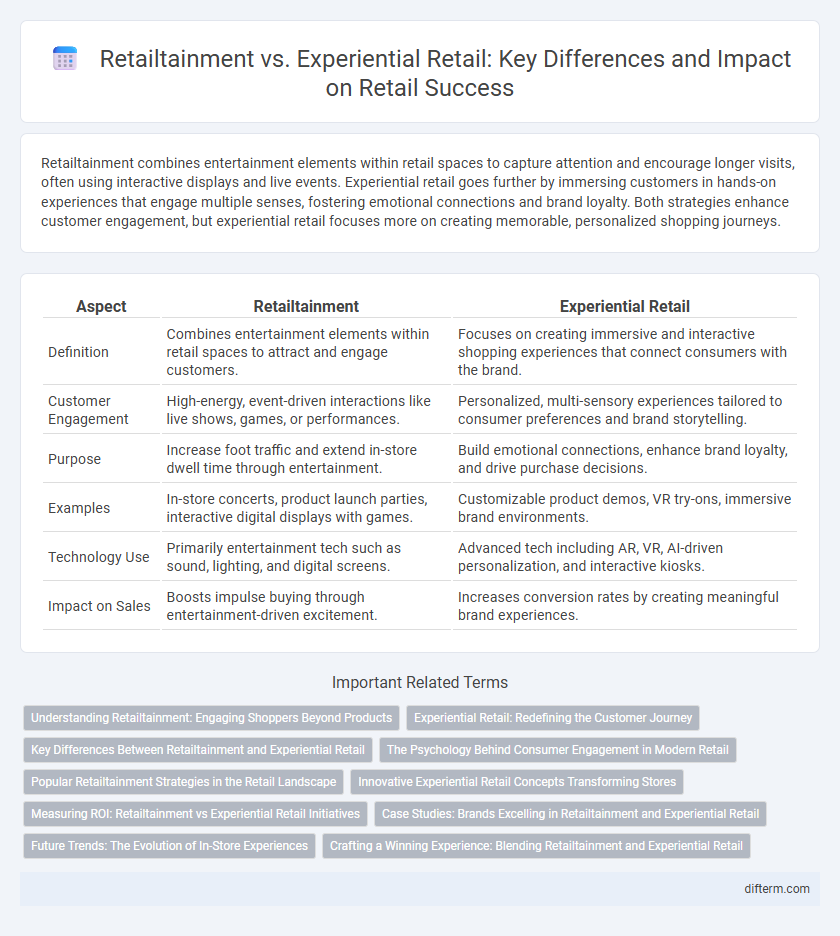Retailtainment combines entertainment elements within retail spaces to capture attention and encourage longer visits, often using interactive displays and live events. Experiential retail goes further by immersing customers in hands-on experiences that engage multiple senses, fostering emotional connections and brand loyalty. Both strategies enhance customer engagement, but experiential retail focuses more on creating memorable, personalized shopping journeys.
Table of Comparison
| Aspect | Retailtainment | Experiential Retail |
|---|---|---|
| Definition | Combines entertainment elements within retail spaces to attract and engage customers. | Focuses on creating immersive and interactive shopping experiences that connect consumers with the brand. |
| Customer Engagement | High-energy, event-driven interactions like live shows, games, or performances. | Personalized, multi-sensory experiences tailored to consumer preferences and brand storytelling. |
| Purpose | Increase foot traffic and extend in-store dwell time through entertainment. | Build emotional connections, enhance brand loyalty, and drive purchase decisions. |
| Examples | In-store concerts, product launch parties, interactive digital displays with games. | Customizable product demos, VR try-ons, immersive brand environments. |
| Technology Use | Primarily entertainment tech such as sound, lighting, and digital screens. | Advanced tech including AR, VR, AI-driven personalization, and interactive kiosks. |
| Impact on Sales | Boosts impulse buying through entertainment-driven excitement. | Increases conversion rates by creating meaningful brand experiences. |
Understanding Retailtainment: Engaging Shoppers Beyond Products
Retailtainment transforms shopping into immersive experiences by integrating entertainment elements such as live events, interactive displays, and themed environments, effectively capturing customer attention and increasing dwell time. This approach goes beyond traditional product presentation, fostering emotional connections and encouraging social sharing, which enhances brand loyalty and drives repeat visits. Understanding retailtainment's role in creating memorable, multi-sensory experiences is essential for retailers aiming to differentiate themselves in a competitive market and boost overall sales performance.
Experiential Retail: Redefining the Customer Journey
Experiential retail redefines the customer journey by creating immersive environments that engage multiple senses, fostering deeper emotional connections with brands. This approach integrates interactive technology, personalized services, and unique in-store experiences to transform shopping into an engaging activity rather than a transactional task. Retailers leveraging experiential strategies report increased customer loyalty, higher dwell times, and a significant boost in sales conversion rates.
Key Differences Between Retailtainment and Experiential Retail
Retailtainment centers on entertainment-driven experiences designed to attract and engage customers through events, performances, or interactive displays, boosting foot traffic and brand awareness. Experiential retail focuses on immersive, personalized shopping experiences that emphasize customer interaction with products and the environment, fostering emotional connections and customer loyalty. Key differences lie in Retailtainment's emphasis on entertainment and short-term engagement versus Experiential Retail's goal of deeper, long-term customer relationships through meaningful experiences.
The Psychology Behind Consumer Engagement in Modern Retail
Retailtainment leverages immersive entertainment elements to captivate consumer attention and evoke emotional responses, enhancing dwell time and brand recall. Experiential retail focuses on creating meaningful, multisensory interactions that foster personal connections and loyalty through authentic brand experiences. The psychology behind consumer engagement reveals that emotional arousal and sensory stimulation significantly influence decision-making, driving higher purchase intent and satisfaction.
Popular Retailtainment Strategies in the Retail Landscape
Popular retailtainment strategies leverage immersive technologies like augmented reality (AR) and virtual reality (VR) to engage customers in interactive product experiences, enhancing in-store engagement and brand loyalty. Experiential retail focuses on creating multisensory environments through personalized services, live events, and tactile product interactions that foster emotional connections with consumers. Retailers increasingly integrate gamification and social media activations to drive foot traffic and encourage user-generated content, bridging online and offline shopping experiences.
Innovative Experiential Retail Concepts Transforming Stores
Innovative experiential retail concepts are revolutionizing stores by seamlessly integrating interactive technology, immersive environments, and personalized customer experiences that drive engagement and brand loyalty. Retailtainment blends entertainment with shopping, creating dynamic spaces featuring augmented reality, live events, and gamified elements, enhancing emotional connections and prolonging store visits. Experiential retail focuses on multisensory experiences that stimulate all senses, such as tactile product demos and sensory branding, transforming traditional retail into memorable, impactful brand interactions.
Measuring ROI: Retailtainment vs Experiential Retail Initiatives
Measuring ROI in retailtainment focuses on immediate engagement metrics such as foot traffic increases, social media interactions, and short-term sales spikes driven by entertainment elements. Experiential retail initiatives require tracking long-term brand loyalty, customer lifetime value, and immersive experience feedback to evaluate their impact on sustained customer relationships. Analyzing data from loyalty programs, repeat purchase rates, and sentiment analysis provides deeper insights into the financial benefits of experiential retail compared to the event-driven returns of retailtainment.
Case Studies: Brands Excelling in Retailtainment and Experiential Retail
Brands like Nike and Apple excel in retailtainment by creating immersive, interactive environments that blend entertainment with shopping, such as Nike's flagship stores featuring in-store basketball courts and Apple's hands-on product demonstrations. Experiential retail pioneers like REI and IKEA emphasize customer engagement by offering workshops, personalized services, and real-life home setups to enhance product discovery and emotional connection. These case studies highlight the strategic difference: retailtainment focuses on entertainment-driven experiences to boost consumer engagement, while experiential retail prioritizes meaningful, sensory interactions that deepen brand loyalty.
Future Trends: The Evolution of In-Store Experiences
Retailtainment merges entertainment with shopping to create immersive and interactive environments that boost customer engagement and dwell time. Experiential retail emphasizes personalized, sensory-rich experiences through technology like augmented reality, AI-driven customization, and immersive storytelling to deepen emotional connections. Future trends focus on integrating virtual and physical retail spaces, leveraging data analytics for hyper-personalization, and creating seamless omnichannel experiences that transform stores into vibrant community hubs.
Crafting a Winning Experience: Blending Retailtainment and Experiential Retail
Crafting a winning experience in retail involves blending retailtainment's entertainment-driven engagement with experiential retail's immersive, customer-centric approach. Incorporating interactive technology, personalized services, and event-based activations enhances consumer connection and drives foot traffic. Retailers leveraging this hybrid strategy achieve higher brand loyalty, increased dwell time, and elevated purchase intent.
Retailtainment vs Experiential Retail Infographic

 difterm.com
difterm.com